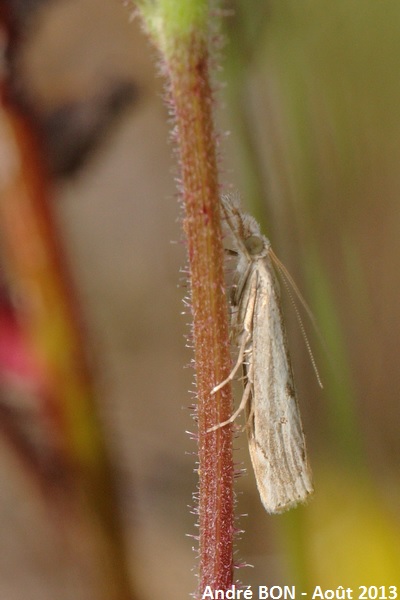
| Elbow-striped Grass-veneer (Agriphila geniculea (Haworth, 1811)) |

|
|
Scientific name: Agriphila geniculea (Haworth, 1811) Common name: Elbow-striped Grass-veneer French name: Crambus anguleux, Crambus des friches. Order: Lepidoptera Suborder: Heterocera Family: Crambidae Subfamily: Crambinae Wingspan: 20-26 mm. Biotope: Dry meadows, heath lands, dunes and other grassy places. Geographic area: Europe, North Africa. Flight time: July to October. Number of generations : 1 Caterpillar: Yellowish white with black spots. The head and the prothoracic shield are dark brown. Host plant: Many grasses, with a preference for short ones, including Sheep's Fescue (Festuca ovina) as an example. Caterpillars grow at the base of plants inside a small silken shelter. |
The Elbow-striped Grass-veneer has more or less pale sand-coloured fore wings. They are crossed by two darker elbow lines, whose point is oriented towards the margin. You can distinguish one line at two third of the wing length, whose point approaches the margin edge, and another one about at mid length. This last one bears a dark brown spot on the middle of the wing. There are specimens on which these lines are very weakly marked and even barely visible. The fringe of the fore wings is silvery grey. The hind wings are pale brownish white with a white fringe. The antennae are thread like. There is a possible confusion with Pediasia contaminella which shows similar lines on its fore wings. The dark brown cross line close to the margin of the wings is outlined with a lighter coloured line on the margin side on Agriphila geniculea. Pediasia contaminella is missing this lighter coloured line. Furthermore this line shows sharp teeth pointing towards the inner side of the wing on Pediasia contaminella. Agriphila geniculea is missing these teeth. |
| [To know more about the Elbow-striped Grass-veneer] [Top] |

|
The cross lines are weekly marked on this specimen but you can guess them. The outer line does not show any tooth and it seems to be outlined by a lighter-coloured line on the margin side. This is what makes me think that this one is Agriphila geniculea. |